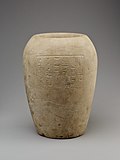Twenty-first Dynasty of Egypt | |||||||||
|---|---|---|---|---|---|---|---|---|---|
| 1077 BC–943 BC | |||||||||
 Gold funerary mask of pharaoh Psusennes I | |||||||||
| Capital | Tanis | ||||||||
| Common languages | Egyptian language | ||||||||
| Religion | Ancient Egyptian Religion | ||||||||
| Government | Absolute monarchy | ||||||||
| Historical era | Third Intermediate Period of Egypt | ||||||||
• Established | 1077 BC | ||||||||
• Disestablished | 943 BC | ||||||||
| |||||||||
The Twenty-first Dynasty of Egypt (notated Dynasty XXI, alternatively 21st Dynasty or Dynasty 21) is usually classified as the first Dynasty of the Ancient Egyptian Third Intermediate Period, lasting from 1077 BC to 943 BC.







